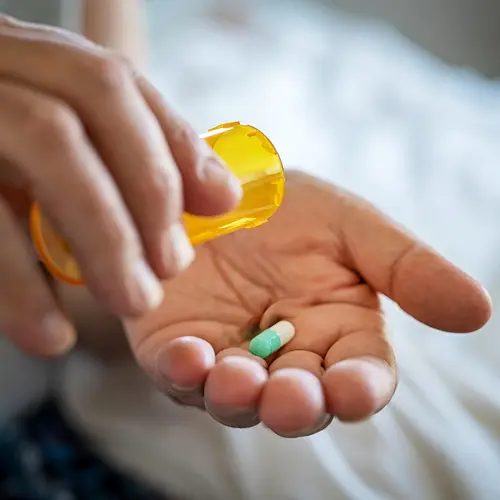Allergy eyedrops are liquid medicines used to treat symptoms of eye allergies. Eye allergy symptoms include:
- A burning feeling in your eye
- Feeling like something is in the eye
- Itchy eyes
- Red (bloodshot) eyes
- Swollen eyelid
- Tearing
An eye allergy can be triggered by the same things that cause hay fever, such as:
- Pollen
- Dust
- Pet dander
Certain medications or contact lenses can also be triggers.
Types of Allergy Eyedrops
Your doctor may first suggest you take these steps:
- Use artificial tears.
- Place a cold cloth on the eyes.
- Avoid your allergy triggers.
Which type of allergy eyedrop you use depends on:
- The cause of your allergy
- Your symptoms
- How much the symptoms affect your daily activities
There are many types of allergy eyedrops. Not all treat all allergy symptoms. For example, one that relieves red eyes may not stop the itching.
Some are sold over the counter. For others you need a prescription from a doctor. Some relieve symptoms quickly. Others provide long-term relief.
The types of allergy eyedrops include:
- Antihistamine
- Anti-inflammatory
- Decongestant
- Mast cell stabilizers
- Multiple action
Antihistamine Allergy Eyedrops
Doctors usually recommend these as the first treatment for eye allergies if you can’t get enough relief without drugs.
If you have itchy, watery eyes, antihistamine eyedrops may make you feel better. These medicines block histamine in the body. Histamine is a chemical that your immune system makes when you come in contact with an allergy trigger. It causes many of your allergy symptoms.
Antihistamine eyedrops can quickly ease your symptoms. But relief may only last for a few hours. It can also cause your eyes to be more dry. You may need to use the drops several times a day.
Antihistamine eyedrops include:
- Azelastine hydrochloride (Optivar)
- Emedastine difumarate (Emadine)
- Levocabastine (Livostin)
Alcaftadine (Lastacaft)
Anti-inflammatory Allergy Eyedrops
These eyedrops fall into two groups:
- Nonsteroidal anti-inflammatory drugs (NSAIDs)
- Corticosteroids
NSAID eyedrops affect certain nerve endings. They change the way your body makes you feel itchy.
Ketorolac (Acular, Acuvail) is the only NSAID approved for the treatment of itchy eyes. Itching usually starts to go away about 1 hour after using the eyedrops. These eyedrops often cause stinging or burning when first placed in the eyes.
Corticosteroid eyedrops are used to treat severe, long-term eye allergy symptoms. Prescription steroid eyedrops include loteprednol (Alrex, Lotemax).
Doctors generally don’t recommend corticosteroid drops for long-term use, unless your case is really severe, due to possible side effects such as increased eye pressure and cataracts.
When you use corticosteroid eyedrops, you should have regular checkups with an eye specialist to check on your eye health. These eyedrops can make you more likely to get:
Decongestant Allergy Eyedrops
These eyedrops can quickly brighten the whites of your eyes and reduce eye redness for a short time. They narrow blood vessels in the eye area. This relieves the red, bloodshot appearance of the eyes but carries long-term risk of “rebound redness,” which is making your eyes permanently bloodshot. As a result, they are not recommended for long-term use.
You can get these eyedrops without a prescription. But doctors don't recommend them to treat eye allergies.
Examples of over-the-counter decongestant eyedrops are:
- Naphazoline HCL (Clear Eyes)
- Phenylephrine HCL (Refresh)
- Oxymetazoline HCL (Visine)
- Tetrahydrozoline HCL
There are some risks. If you use them for too long, it can make your eye problem worse, with “rebound redness.” Redness and eye swelling can continue even when you stop using the drops.
If you have glaucoma you should never use decongestant eyedrops.
Mast Cell Stabilizer Allergy Eyedrops
These are among the newest types of eyedrops. They help prevent the release of histamine and other chemicals made by your body during an allergic reaction.
Mast cell stabilizers are made to prevent your symptoms.
You may be able to use these drops for many months without any side effects. If you wear contacts, mast cell stabilizers may let you wear them longer.
Over-the-counter mast cell stabilizer drops include:
Prescription mast cell stabilizer eyedrops include:
- Cromolyn (Crolom)
- Lodoxamide (Alomide)
- Nedocromil sodium (Alocril)
- Pemirolast potassium (Alamast)
Multiple-Action Allergy Eyedrops
Some eyedrops contain more than one type of medicine. These are called dual-action or multiple-action eyedrops.
Antihistamine/decongestant combination eyedrops reduce eye itching, watery eyes, and redness. Examples include:
- Antazoline phosphate/naphazoline HCL (Vasocon-A)
- Pheniramine maleate/naphazoline HCL (Opcon-A and Naphcon-A)
Antihistamine/mast cell stabilizer combination eyedrops treat and prevent:
- Eye itching
- Redness
- Tearing
- Burning
These newer eyedrops are especially helpful for people with a condition called allergic conjunctivitis. Examples include:
- Epinastine (Elestat)
- Ketotifen (Alaway, Zaditor)
- Olopatadine hydrochloride (Pataday, Patanol)
- Cetirizine (Zerviate)
Side Effects and Risks
As with any medicine, you should always follow the recommended instructions on the label. You shouldn’t use over-the-counter eyedrops for more than 2 to 3 days. If you use them for longer than that, it can make matters worse.
If you have an eye infection or glaucoma, you shouldn’t use eyedrops. Talk to your doctor about other options.
Some eyedrops may sting or burn when you place them in your eyes. It can help to store them in your fridge.
You can’t use many eyedrops while you wear contact lenses. Your doctor may tell you to remove your lenses before you use the drops and wait at least 10 minutes before you put them back in. Or you may not be able to wear contact lenses at all during treatment with eyedrops.
You’ll need to use most allergy eyedrops several times a day.

